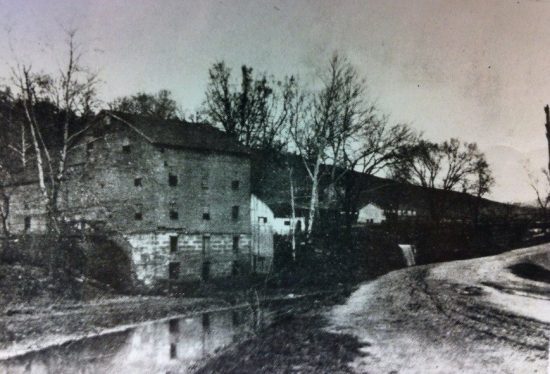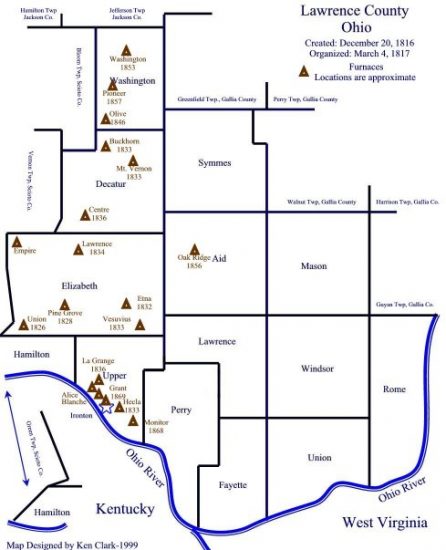Lawrence County, Ohio
Built: 1826
By: JAMES RODGERS & CO.
Researched by Sharon M. Kouns and Martha J. Martin-Kounse
Union Furnace – Union Tp. – In 1826, James Rodgers, John Means, John sparks, and Valentine Fear built Union furnace, the first in the county. The creek Union Furnace was built on was called Indian Run for so many trees marked by the Indians.

Union Furnace was built in 1826 by Jas. Rodgers, John Means, John Sparks, and Valentine Fear. The firm name was Jas. Rodgers & Co. It went into blast in 1827, and Thos built its first fire. W. Means, the senior member of Means, Kyle & Co., of Hanging Rock, Ohio.
It produced but a ton daily of cold blast charcoal iron, but the experience of the managers raised the production to two and a half tons daily, which was considered very well. The firm name was afterward changed to Jno. Sparks & Co., afterward, owned by Thos. W. Means and David Sinton, firm name Sinton & Means.
The furnace is now dismantled, and the land is owned by Means, Kyle & Co., who also own the Pine Grove and Ohio furnaces and the property attached thereto. In those days, wages were low. Wood was cut for 25 cents per cord; corn cost 12 ½ cents per bushel; hay from $4 to $6 per ton. And whiskey was the almost necessary adjunct to every bargain and contract.
The Stark County Democrat. Canton, Ohio October 24, 1884 – FINANCIAL BREAK UP.
The Union Iron Company of The Union Iron Company of Hanging Rock Succumbs. With Liabilities Estimated at $600,000
Other Interests Involved – Various Other Interests Involved
Various Forms of Crookedness. Portsmouth, O. October 22.
The Hanging Rock Iron region, of which Portsmouth and Ironton are the centers, is now undergoing a severe financial strain. Some days ago, the Union Iron Company of this place, comprising Washington and Monroe furnaces with several thousand acres, asked for a receiver. Liabilities were stated to be $300,000. They began creeping up until now they reached $600,000.
The concern has made several fortunes in the last ten years. It had the implicit confidence of its employees, who should have known if it was embarrassed, and its collapse was an utter surprise, increased by the vastness of its liabilities. There are ugly suspicions as to the cause of which Western silver mining speculations are mentioned.
Last Saturday, John Campbell of Ironton, its heaviest stockholder, found himself compelled to make an assignment, his liabilities, mostly endorsements, being several hundred thousand. He had for years allowed others to control and manage this company, in whom he had implicit confidence. He is 77 years old and owns all or most of Howard, Olive, Gallia, Buckhorn, and Hecla furnaces, besides those first mentioned.
His affairs are not yet straightened out, so he cannot tell if he can save any part of his vast fortune. If he is hopelessly involved, it means distress to thousands and utter ruin to many. Besides these troubles, it is intimated that one National Bank in this section has loaned one party implicated in mining ventures, and one of these furnaces several times its legal allowance to any borrower. The bank wins will not be hurt, but an officer may get into serious trouble.
WILLIAM LOUDERBACK’S RECOLLECTION OF UNION, THE FIRST IRON FURNACE
Ironton Register, November 10, 1892
Of the old men of our town, no one holds his age better than William Louderback, who is nearly 82 years of age. He has worked nearly all his life about the furnaces of the Hanging Rock region, and his fund of recollections of early iron making is rich. The following is the substance of a conversation with him [talking about Union the First Iron Furnace].
“My father was Peter Louderback, who moved from Pennsylvania at an early day and settled in Scioto county about three miles from where Sciotoville now stands. I was born on April 11, 1811. When I was four years old, I was placed with Jesse Wolf, who lived in Lawrence county about three miles from where Center furnace stands.
Wolf was a prosperous pioneer. In addition to his farm, he ran a small still and made enough runs each year to supply the neighborhood. He brewed some beer, also. During the hunting season, he would kill many deer and would sometimes have from 60 to 70 deer skins to sell in the spring. When I was about 13 years old, I went to live with Joshua Horner at Kelley’s Mills on Pine Creek.”
“While living there, Union Furnace was built. It was the first iron furnace in southern Ohio, and they began building it when I was 14. It was only about a mile and a half from where I lived, and I hauled charcoal to it when it began running. Charcoal was then hauled in 150-bushel beds. We used oxen altogether, for there were no mules in the country then.
James Rogers, the furnace manager, was the first man who counted five pecks of charcoal, a bushel. The furnace was in a primitive order. It made only about three tons a day. The output on Sunday was run into pigs, but the output during the week was made into hollow-ware, stoves &c. The molten metal was ladled out from the hearth and poured into the various molds. A man was employed to skim the metal in the hearth, and I have done the work many times.”
“John Sparks was the name of one of the owners. David Sinton, his nephew, was a boy of all work about the store and office. I have heard that Sinton died a millionaire in Cincinnati. Thos. W. Means was bout the furnace also.” [Union Furnace was built in 1826 by John Means, a South Carolinian, who settled with his slaves in Lawrence county in 1819. He was an abolitionist and came to Ohio so that his slaves might be free. – ED.]
“Slaves used to run away from Kentucky quite often in those days. I remember many who went through it. There were so many passing that one man made a living by catching them and taking them back to Greenup, Ky. Once, a slave stopped at the home of a man named John Bruce and begged a breakfast. He was invited in, and while eating, he saw Bruce’s rifle hanging over the door. Something scared the runaway, and he jumped up, grabbed the rifle, and shot Bruce dead. He then escaped.”
“The pioneers believed that the Indians had a lead mine on Raccoon Run, which flows into Pine Creek. Many a search was done for it, but only little pellets of lead were found.” – Jackson Standard.

“I have worked at Franklin, Junior, Buckhorn, Olive, Vernon, and other furnaces and came to Jackson from Buckhorn. I enlisted in the 4th Ohio Calvary at Olive and served seven months. My son Jacob served in the war also.”
Tidbits about Union Furnace – various sources
Union Furnace was built in 1826 by Jas. Rodgers, John Means, John Sparks, and Valentine Fear. The firm name was Jas. Rodgers & Co. It went into blast in 1827, and Thos built its first fire.
W. Means, the senior member of Means, Kyle & Co., of Hanging Rock, Ohio. It produced but a ton daily of cold blast charcoal iron, but the experience of the managers raised the production to two and a half tons daily, which was considered very well.
The firm name was afterward changed to Jno. Sparks & Co., afterward owned by Thos. W. Means and David Sinton, firm name of Sinton & Means. The furnace is now dismantled, and the land is owned by Means, Kyle & Co., who also own the Pine Grove and Ohio furnaces and the property attached thereto.
In those days, wages were low. Wood was cut for 25 cents per cord; corn cost 12 ½ cents per bushel; hay from $4 to $6 per ton. And whiskey was the almost necessary adjunct to every bargain and contract.
Abner Dilley worked at the Union furnace as a roster or general hand about the furnace for $6 per month. A yoke of oxen was worth $20 to $40, but they were extra cattle selling for $40. At that time, there was very little land except along the bottom of the river and the larger streams. Most of the land was subject to entry and purchase by the government for $1.25 per acre. Source: Ironton Register August 25, 1904, by Thos. A. Walton.
Thomas Williamson Means became storekeeper at Union Furnace, which his father and others were then building four miles from Hanging Rock. This was the first blast furnace built in Ohio in the Hanging Rock iron region, and he had the pleasure of first “firing” it. The old Steam, Hopewell, Pactolus, and Argillite were the only furnaces previously in that region and were in Kentucky.

0 Comments